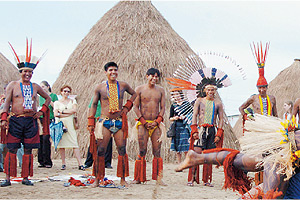This is the largest country in South America (covering half the continent), and the fifth largest and the sixth most populated in the world. Its natural resources make it an agricultural and industrial giant. It also has the richest and most extensive ecosystem in the world: the Amazon Rainforest.
An area of plains and plateaus
Brazil is bounded to the north by Colombia, Venezuela, Guyana, Suriname, French Guyana and part of the Atlantic Ocean, to the east by the Atlantic Ocean, to the southeast by Uruguay, Argentina and Paraguay and to the west by Argentina and Peru.
Brazil’s geography does not display high mountainous formations and most mountains have altitudes below 500 meters above sea level. It is divided in two great plateaus and three areas of plains:
– The Guyana Highlands, which encompass the mountainous area and tableland north of the Amazon River, in the extreme north of the country.
– The Brazilian plateau, located in the central part of the country, which encompasses a large part of the territory.
– The plains and lowlands of the Amazon in the north of the country and below the Guyana Highland. These have three different levels: valleys, fluvial terraces and low plateaus.
– The Pantanal plains, in the western and the southwestern part of the State of Mato Grosso.
– The coastal plains and lowlands, stretching from Maranhão to the south of the country.
A country of great natural resources
Brazil’s economy is the largest in Latin America and the 11th largest in the world. It is one of the world’s main producers of food products, most notably coffee, being the second largest exporter of this product after Colombia.
In the last few years, cereal harvests have exceeded 110 million tons, the most prominent of these being soy, with a harvest of 50 million tons.
It also has the biggest herd of commercial livestock in the world, with 198 million heads of cattle. In 2005, the exports in this sector surpassed 1 billion US dollars.
Moreover, this country also has a great wealth of minerals. It is the world’s largest producer of iron, but it also produces quartz, chrome, manganese, industrial diamonds, precious stones, gold and nickel, among others.
A Federative Republic
Brazil is divided into 26 states and a Federal District, with a total of 5,024 local governments. According to the Political Constitution promulgated on the 5th of October 1988, the President of the Republic, who acts as Head of State and of the Federal Government, is elected for a period of four years, and may be re-elected.
Legislative power is composed of two houses: the Senate, with 81 members, and the Chamber of Deputies with 513. All members are elected through direct vote, for mandates of 8 or 4 years, respectively.
Judicial power comprises two types of justice: common and special. Common Justice is exercised by Federal Courts and State and Federal District Courts. Special Justice is constituted of Labour Courts, Electoral Courts and Military Courts.
Mixed backgrounds
According to the Census conducted in the year 2000, the Brazilian population is predominately young, as 60% of its inhabitants are under the age of 29.
Brazilians are descended from what is probably the most varied mix of races in the world, a consequence of the mix between Portuguese colonists, indigenous people and African slaves, in their majority from the areas now known as the nations of Nigeria, Benin and Angola.
During the 19th century, European and Japanese immigrants added a new component to Brazil’s ethnic mix. In fact, in 1969, more than 200,000 Japanese arrived in Brazil and currently form the largest population of this origin outside Japan. It is calculated that today 55% of the population is of European descent, 38% is mulatto, 6% of African descent and 1% of Asian descent.








 Muere Evita
Muere Evita